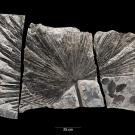
Professor Isabel Montañez’s era-spanning research
Our planet’s history is one of extreme climate cycles that repeat across time, with insights into the Earth’s previous responses still accessible today. This is part of what Isabel Montañez is working to understand — what these moments might teach us about our changing climate and future climate conditions.
Montañez, a distinguished professor and a chancellor’s leadership professor in the Department of Earth and Planetary Sciences, joined UC Davis in 1998. She is known for her interdisciplinary, integrated multi-proxy and modeling research approaches. Montañez is particularly regarded for her studies that use proxies of atmospheric carbon dioxide concentrations and prehistoric land and sea conditions with climate modeling efforts to reconstruct past global and regional climates, specifically during periods of warming and major transitions.
“That's why we study the past: to tell you on the longer decadal scale, this is how the Earth system responds to climate change,” she said.
Montañez was born in Geneva, Switzerland, and grew up in Switzerland, the United Kingdom and Pennsylvania. She graduated from Bryn Mawr College with a degree in geology and from Virginia Tech in 1989 with a Ph.D. in geosciences.
In 2021, Montañez was inducted into the National Academy of Sciences for her approach to studying different components of the Earth system and what links a range of past climates over large spectrums of time. This approach had previously been detailed in a two-year National Academies study, “Understanding Earth’s Deep Past: Lessons for our Climate Future,” where Montañez describes how rocks and sediments millions of years old can inform the Earth’s future responses to climate change.
Like an archaeologist who understands past worlds through the remains of previous civilizations, Montañez analyzes, among other records, “fossil drip water” in cave deposits to inform how regional climate patterns with future, warming could look.
“The rainfall that went through the soil into the cave and dripped onto this growing mineral deposit — is trapped in the stalagmite. We found a way to be able to extract that,” Montañez said, comparing the process to Jurassic Park, where dinosaur DNA is extracted from a fossilized mosquito.
“We've been able to advance this science because we can produce unique records, and we can put precise ages on them where there may not be any volcanic deposits to date.”
The Institute of the Environment
In 2021, Montañez became the director of John Muir Institute of the Environment at UC Davis, which supports innovation and discovery aimed at solving real-world environmental problems.
“Campus has traditionally, appreciated its institutes and centers, and recognizes the importance of what the role they can play that an individual department or even college can't.”
Since becoming Director, she has built the California Collaborative for Natural Climate Change Solutions — or C4NS — housed at the Institute of the Environment. This group is running field trials throughout California that apply finely ground volcanic rock (basalt) — made of minerals with high weatherability — as soil amendments to different types of landscapes to determine their ability to capture atmospheric carbon dioxide through silicate weathering, the process of removing carbon dioxide from the Earth’s atmosphere and storing it in the ocean, cooling the Earth’s temperature. Supported by a nearly $24 Million grant from the Department of Energy’s Negative Carbon Energy Earthshot program, this Davis study is part of a new Terraforming Soil Energy Earthshot Research Center.
Montañez acknowledges the difficulty individuals may have in facing the monumental challenges threatening our earth’s future. She finds relief in the classroom.
“Once a year, I teach a climate change class to a couple hundred students, and I really enjoy doing it because they’re freshmen, a lot of them — kind of wide-eyed — but it is very satisfying to be able to talk to them about all the cool solutions for combatting the cause and impacts of climate change.”
She also cited the impact of the Inflation Reduction Act and the increased private investment in researching climate mitigation strategies and alternative energies and, particularly, individuals’ greater awareness of their changing climate – and that awareness leading to calls for change.
“Folks are understanding that the seasonal changes are different when comparing them against their childhood,” Montañez said. “I think it's more palpable than ever before, for better or for worse.”
This article originally appeared on the UC Davis News website.
YOU MAY ALSO LIKE THESE STORIES

Taking the Earth’s Temperature Over the Past 485 Million Years
Palm trees in Alaska, crocodiles in Wyoming: Fossils show that Earth’s temperature has changed over hundreds of millions of years. Now a new study co-led by the Smithsonian and the University of Arizona, with Professor Isabel Montañez of the UC Davis Department of Earth and Planetary Sciences, has produced a curve of global mean surface temperatures over the past 485 million years.

A Career Built in Deep Time
Isabel Montañez’s fascination with ancient Earth began with fossils. As a child growing up in the shadow of Pennsylvania’s Appalachian Mountains, Montañez and her father spent weekends exploring rocky outcrops behind shopping centers and flanking railroad cuts. They’d pick away at the rocks, opening them up and revealing remnants of the ancient past held within: trilobites, echinoderms, fish and other extinct marine life.
